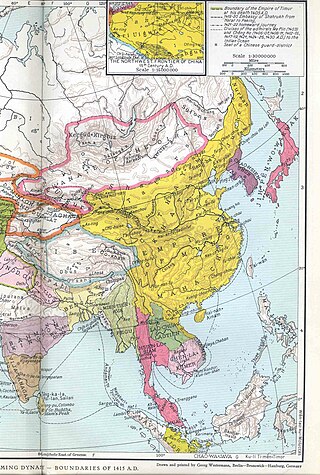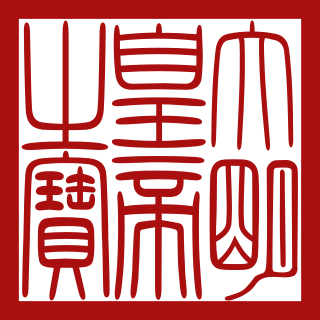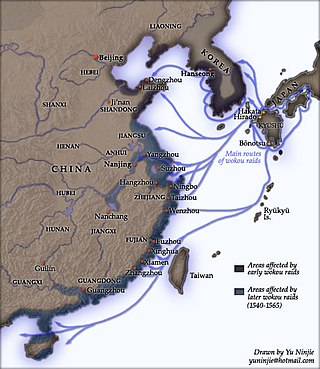Related Research Articles

The Ming dynasty,officially the Great Ming,was an imperial dynasty of China,ruling from 1368 to 1644 following the collapse of the Mongol-led Yuan dynasty. The Ming dynasty was the last imperial dynasty of China ruled by the Han people,the majority ethnic group in China. Although the primary capital of Beijing fell in 1644 to a rebellion led by Li Zicheng,numerous rump regimes ruled by remnants of the Ming imperial family—collectively called the Southern Ming—survived until 1662.
The Censorate was a high-level supervisory agency in Imperial China,first established during the Qin dynasty. It was a highly effective agency during the Mongol-led Yuan dynasty (1271–1368). During the Ming dynasty (1368–1644),the Censorate was a branch of the centralized bureaucracy,paralleling the Six Ministries and the five Chief Military Commissions,and was directly responsible to the emperor. The investigating censors were "the eyes and ears" of the emperor and checked administrators at each level to prevent corruption and malfeasance,a common feature of that period. Popular stories told of righteous censors revealing corruption as well as censors who accepted bribes. Generally speaking,they were feared and disliked,and had to move around constantly to perform their duties.

Tusi,often translated as "headmen" or "chieftains",were hereditary tribal leaders recognized as imperial officials by the Yuan,Ming,and Qing dynasties of China,and the Later Lêand Nguyễn dynasties of Vietnam. They ruled certain ethnic minorities in central China,western China,southwestern China,and the Indochinese peninsula nominally on behalf of the central government. As succession to the Tusi position was hereditary,these regimes effectively formed numerous autonomous petty dynasties under the suzerainty of the central court. This arrangement is known as the Tusi System or the Native Chieftain System. It should not be confused with the Chinese tributary system or the Jimi system.
Charles Oscar Hucker was an American historian and Sinologist who was a professor of Chinese language and history at the University of Michigan. He was regarded as one of the foremost historians of Ming dynasty China and a leading figure in the promotion of academic programs in Asian Studies during the 1950s and 1960s.
The Three Departments and Six Ministries system was the primary administrative structure in imperial China from the Sui dynasty (581–618) to the Yuan dynasty (1271–1368). It was also used by Balhae (698–926) and Goryeo (918–1392) and various other kingdoms in Manchuria,Korea and Vietnam.
The Nine Ministers or Nine Chamberlains was the collective name for nine high officials in the imperial government of the Han dynasty,who each headed one of the Nine Courts and were subordinates to the Three Councillors of State.
The Grand Secretariat,or the Cabinet,was nominally a coordinating agency but de facto the highest institution in the imperial government of the Chinese Ming dynasty. It first took shape after the Hongwu Emperor abolished the office of Chancellor in 1380 and gradually evolved into an effective coordinating organ superimposed on the Six Ministries. There were altogether six Grand Secretaries,though the posts were not always filled. The most senior one was popularly called Senior Grand Secretary. The Grand Secretaries were nominally ranked as mid-level officials,ranked much lower than the Ministers,heads of the Ministries. However,since they screened documents submitted to the emperor from all governmental agencies,and had the power of drafting suggested rescripts for the emperor,generally known as piàonǐ (票擬) or tiáozhǐ (條旨),some senior Grand Secretaries were able to dominate the whole government,acting as de facto Chancellor. The term nèigé itself is now used to refer to the modern cabinet in Chinese.
The Ministry of Personnel was one of the Six Ministries under the Department of State Affairs in imperial China,Korea,and Vietnam.
Hu Weiyong was a Chinese official of the early Ming dynasty and a close adviser of the Hongwu Emperor. In the second half of the 1370s,he headed the civil administration of the empire. However,in 1380,he was accused of treason and executed. The subsequent purge cost the lives of tens of thousands of people.

The House of Zhu was the imperial house that ruled the Ming dynasty of China from 1368 to 1644. However,the Ming state continued in the southern region until 1661,but its territory gradually decreased. The Ming was the last imperial dynasty of China ruled by the Han people. After its downfall,China was conquered by the Manchu-led Qing dynasty (1636–1912). The Han people's Chinese nation state was only restored after the fall of the Qing in 1912,with the establishment of the Republic of China.
The Imperial Clan Court or Court of the Imperial Clan was an institution responsible for all matters pertaining to the imperial family under the Ming and Qing dynasties of imperial China. This institution also existed under the Nguyễn dynasty of Vietnam where it managed matters pertaining to the Nguyễn Phúc clan.
Chen Mingxia was Grand Secretariat and President of Ministry Personnel of the Qing dynasty. He was from Liyang in Jiangsu and was a Chinese official during the Shunzhi period (1644–1661) of the Qing dynasty (1644–1912). Before joining the Qing in early 1645,he had successively served the Ming dynasty (1368–1644) and the short-lived Shun regime of rebel leader Li Zicheng (1602–1645). He then served in the highest ranks of the Qing bureaucracy,being promoted to Grand Secretariat of the empire.
A xunfu was an important imperial Chinese provincial office under both the Ming and Qing dynasties. However,the purview of the office under the two dynasties differed markedly. Under the Ming dynasty,the post originated around 1430 as a kind of inspector-general and ad hoc provincial-level administrator;such a xunfu is usually translated as a grand coordinator. However,since the mid-17th century,xunfu became the title of a regular provincial governor overseeing civil administration in the Qing dynasty.

The Jiajing wokou raids caused extensive damage to the coast of China in the 16th century,during the reign of the Jiajing Emperor in the Ming dynasty. The term "wokou" originally referred to Japanese pirates who crossed the sea and raided Korea and China;however,by the mid-Ming,the wokou consisted of multinational crewmen that included the Japanese and the Portuguese,but a great majority of them were Chinese instead. Mid-Ming wokou activity began to pose a serious problem in the 1540s,reached its peak in 1555,and subsided by 1567,with the extent of the destruction spreading across the coastal regions of Jiangnan,Zhejiang,Fujian,and Guangdong.
The Nine Courts were nine service agencies in Imperial China that existed from the Northern Qi dynasty (550–577) to the Qing dynasty (1644–1912). Headed by the Nine Chamberlains,the offices were subordinate to the Three Departments and Six Ministries. They were mostly ceremonial in nature and held a fair amount of power. During the Ming dynasty,the heads of the nine court transitioned away from referring to the nine courts,but to the Six Ministries,the Censorate,the Office of Transmission,and the Grand Court of Revision. The number of courts was not always nine throughout history.
The Ministry or Board of Revenue was one of the Six Ministries under the Department of State Affairs in imperial China.
The Three Bureaus traditionally refer to the Bureau of Salt and Iron Monopoly,Tax Bureau,and Census bureau that originated during the Song dynasty. However the Three Bureaus have been used to refer to different institutions at different points in Chinese history. In the Eastern Han (25-220),it included posts such as Defender-in-Chief (taiwei),Minister of Education (situ),and Minister of Works (sikong). In the Tang dynasty (618-907),it referred to the Censorate (yushitai),the Chancellery,and the Palace Secretariat. During the Ming dynasty,it referred to three provincial level institutions:the regional military commission,the Provincial Administration Commission,and the Provincial Surveillance Commission.
The Ministry of Works or of Public Works was one of the Six Ministries under the Department of State Affairs in imperial China.
The Ministry of War was one of Six Ministries under the Department of State Affairs in imperial China.

The administration of territory in dynastic China is the history of practices involved in governing the land from the Qin dynasty to the Qing dynasty (1644–1912).
References
Citations
- ↑ Hucker (1958), p. 32.
Sources
- Hucker, Charles O. (1958), "Governmental Organization of The Ming Dynasty", Harvard Journal of Asiatic Studies, 21: 1–66, doi:10.2307/2718619, JSTOR 2718619.